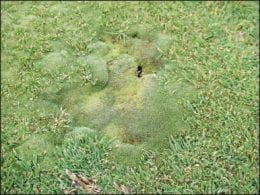Silvery thread moss has been an increasing problem on golf course putting greens over the past couple of decades. Moss is a bryophyte, and that makes it different from most plants. It doesn’t have roots, but rather rhizoids that serve as an anchor, but aren’t as efficient at absorbing water and nutrients compared to roots. It also grows across a wide range of temperatures. It can be actively growing when creeping bentgrass or annual bluegrass appears dormant in late fall or early spring. It can also experience severe drought for months (or years), and regrow once water returns; no other weeds we deal with in turf are that resilient. Research was done on silvery thread moss over several years at K-State by graduate students Dr. Cole Thompson (now Director of Research for the USGA) and Dr. Zane Raudenbush (Dr. Raudenbush just left The Ohio State University to join Davey Tree Company). Here are some things to know regarding how management of putting greens will influence moss that came from their research:
Things that make it happier:
- Mowing lower promotes more moss encroachment. For example, research showed that mowing at 0.125 in vs. 0.157 in resulted in greater moss populations.
- Areas that are thin are susceptible to moss encroachment, so maintain turf density.
- Moss loves water. If you’re watering frequently, you’ll favor its growth.
- Soluble nitrogen applied as a liquid on a frequent interval (spoon feeding) encourages the growth of moss.
Things that help suppress it:
- Mow higher and maintain turf density.
- Water less frequently while still meeting the needs of the turf.
- Fertilize with granular products that allow slower N release.
- Core aerify, verticut, and topdress. Although some may think they could spread moss with cultivation, research has shown that moss populations can be reduced by these practices, which is due in part because the moss colonies are disturbed and allow creeping bentgrass to occupy those areas.
- Apply products for moss suppression. The most popular product used for this is Quicksilver, which contains the active ingredient carfentrazone-ethyl and is labeled for use on greens. Follow the label on Quicksilver for effective moss suppression (don’t expect complete control); using this or other products labeled for moss in combination with aforementioned cultural practices will be the best approach.
Here are some useful resources on moss:
An article on the K-State webpage that give more information on moss biology and control: https://www.plantpath.k-state.edu/extension/documents/turf/moss_2015.pdf
A video by Dr. Zane Raudebush, former K-State graduate student who conducted research on moss here and as a faculty member at The Ohio State University: https://www.turfnet.com/turfnet-tv.html/winfieldtv/raudenbush_silvery_thread_moss/
A summary of the research Dr. Raudenbush did at K-State in Golf Course Management magazine: https://www.turfnet.com/turfnettv.html/winfieldtv/raudenbush_silvery_thread_moss/
Some specifics regarding N fertilization and moss:
https://www.golfdom.com/nitrogen-fertilization-and-silvery-thread-moss/
***Mention of trade names or commercial products in this article is solely for identification purposes and does not imply recommendation or endorsement, nor is criticism implied of similar products not mentioned by Kansas State University.***
Don’t forget to follow the K-State Turf and Landscape Team on Twitter @KSUTurf
Also, visit our facebook page www.facebook.com/KSUTurf



